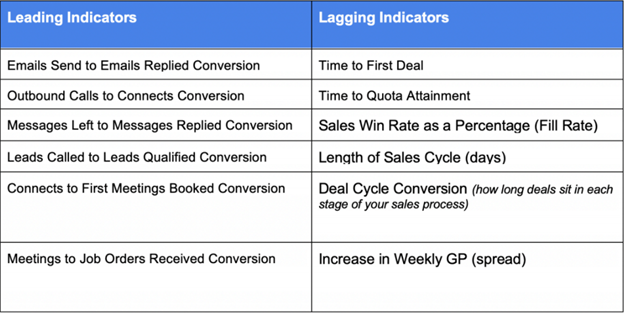1 min read
Most Staffing Firms are Not Built to Scale, But to Survive
Most staffing firms don’t struggle to scale because their teams aren’t working hard. They struggle because they don’t have a real go-to-market...
4 min read
![]() Dan Fisher
:
Jun 1, 2021 6:59:52 AM
Dan Fisher
:
Jun 1, 2021 6:59:52 AM

For revenue leaders including sales enablement, learning and development (L&D) leaders, you know sales and recruiter training is necessary in order for your team to improve productivity and effectiveness. But nowadays, you have to demonstrate the quantifiable value of your training programs in order to win the resources and budget you need to deliver those programs. Once you understand the formula for tracking and measuring sales training ROI, you have to understand metrics for tracking and measuring sales training ROI.
quantifiable value of your training programs in order to win the resources and budget you need to deliver those programs. Once you understand the formula for tracking and measuring sales training ROI, you have to understand metrics for tracking and measuring sales training ROI.
There are three general types of training metrics you need to understand for tracking and measuring the effectiveness of your sales training programs and quantifying your ROI.
Leading Indicators
Leading indicators give us early indications of performance and likelihood for future success. These indicators or “inputs” lead to results by showing the progress you’re making toward your ultimate goal, revenue growth. Conversion rates are a good example of leading indicators that can help you predict future performance and track and measure the impact of your sales training.
There are two primary reasons for tracking leading indicators. First, any sales training program worth its salt should help sellers improve their effectiveness, I.E, conversion ratios. Second, you’re tracking and measuring conversion ratios that occur early in the sales process or at the “top of the funnel” because it gives you quick feedback on what is working or not working. This is what enables you to iterate your training for continuous improvement.
Finally, and this is very important, your leading indicators or “inputs” influence your lagging indicators or the “outputs.”
Lagging Indicators
lagging indicators are the “outputs” or results of your training and generally take a longer time to measure and impact. Placements, gross profit, revenue and net new bookings are all common examples of lagging indicators.
Keep in mind that these metrics all share a common trait; they measure the past. The problem with measuring results or the past is it is too late to do anything about them. But you need to track and measure lagging indicators to quantifiably demonstrate the ROI of your sales training efforts.
The table below illustrates common sales training leading and lagging indicators.

Your objective is to demonstrate how your sales training is improving conversion rates and contributing to your growth.
Return on Expectations (measuring skill, knowledge, behavior adoption)
Many companies track and measure Return On Expectations (ROE) rather than ROI or in addition to. This means setting behavioral targets for your training program. Rather than just trying to tie sales training to the financials, you tie it to behavioral change. You track and measure whether or not your sales reps are actually doing what they were taught to do in training.
For example, YOH enrolled a group of sellers in Menemsha Group sales training and one of their goals was to improve their conversion ratios of outbound phone connections to meeting conversions. They wanted to reduce the number of connections it took a seller to schedule a first-time appointment with a new prospect. They were looking to shorten their sales cycle. To achieve this, we tracked and measured the following behavioral targets:
By tracking adoption of the skills and tools taught in the training we could correlate ROE back to conversion ratios and the results. In this case it was it was first-time appointments or sales meetings with new prospects.
To take it a step further, we could also compare group cohorts, sales reps and sales teams trying to schedule first-time appointments with new prospects who either had not yet received the training or who did but had made no attempt to adopt the skills and tools taught in training with those who did adopt and apply the training.
Know Your Baseline Data
Before launching any training program, you’ll need to be clear about what specific results you’re looking to achieve and how the program will impact the business, and how you’re going to track and measure it. You need to be sure to take your time analyzing your training content and understanding how it aligns with, and supports the company’s goals.
The key to figuring out sales training ROI is to link it to measurable and quantifiable results. Learner feedback surveys and course completion metrics are not enough. What you’re looking for are metrics that show an improvement in your sales team’s effectiveness and performance. To begin building your business case for demonstrating ROI, you need to identify how effectively your sales team is currently (and historically) performing. This means you need to collect some baseline data. Consider the following data points:
These are examples of sales effectiveness metrics, all of which your sales onboarding and sales enablement function is designed to improve. These are the metrics that are near and dear to the hearts of your sales and recruiting leaders, CEO and CFO. And if they’re not, they should be, which gives you the opportunity to educate them on what they should be tracking and measuring and why.
Capturing these metrics will give you a good handle on how your sales team is performing and where you might want to focus your sales training efforts. For each new group cohort that consumes your training such as sales onboarding, track and measure their results and benchmark them against your baseline data. Your objective is to continuously iterate and improve results.

1 min read
Most staffing firms don’t struggle to scale because their teams aren’t working hard. They struggle because they don’t have a real go-to-market...

In my previous post, How to Prevent Unexpected Contract Terminations, I shared how systemizing consultant and client check-ins at key milestones...

About a year ago, I was serving as the fractional revenue leader, managing sales and recruiting for a client.